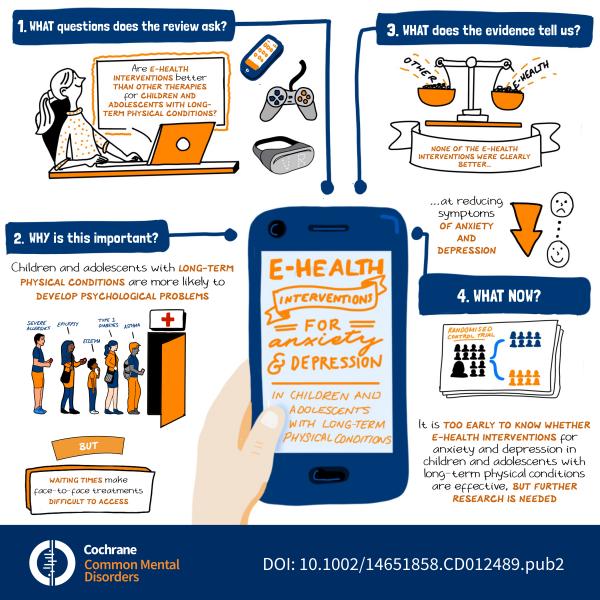
 How to disseminate Cochrane Reviews with network meta-analysis (NMA)
How to disseminate Cochrane Reviews with network meta-analysis (NMA)
Cochrane Wounds
Aim: To provide some ideas and tips for presenting the results of network meta-analyses to different audiences
Category: Formatting evidence for dissemination
Target audience for dissemination: Any, but particularly policymakers and guideline developers
Summary: Network meta-analyses are useful products for those who need to make health decisions across a range of different possible options. The methods and results are often complex and need to be communicated in a clear way so that end users can understand and use them in making health-decisions. This Learning Live webinar includes presentations from members of the Cochrane community who discus some of the challenges and strategies for making reviews with NMA more accessible and useful.
Date: May 2020
Watch more
 Social media in 10 minutes a day
Social media in 10 minutes a day
Cochrane Pain, Palliative and Supportive Care
Aim: To provide an overview of the tools and techniques used by the Pain, Palliative and Supportive Care Review Group to optimise the management of their social media
Category: Dissemination channels
Target audience for dissemination: Social media users
Summary: The Cochrane Pain, Palliative and Supportive Care Review Group is a busy CRG managing a portfolio of over 300 reviews. They recognise the importance of dissemination in helping their work reach a wider audience and use Twitter, Facebook social media platforms. In this blog they share with what their week in social media looks like including the tools and processes they use to try to minimise the time spent whilst optimising the impact.
Date: June 2019
Read more
 Visualising Cochrane evidence in practice: experience from a Cochrane Group
Visualising Cochrane evidence in practice: experience from a Cochrane Group
Cochrane Common Mental Disorders
Aim: To use a visual storytelling infographic format to share the results of a Cochrane Review.
Category: Formatting evidence for dissemination, Involving end users in dissemination
Target audience for dissemination: Young adults with lived experience of depression
Summary: In this Cochrane Learning Live Webinar the Cochrane Common Mental Disorders Review Group authors and editorial team worked with graphic designers to share evidence for one of their reviews in a new ‘visual storytelling’ format. The presenters talk about the process of including consumers in the design of the product, what worked well and the challenges they encountered.
Date: April 2019
Watch more
 Using a website to provide health information to the public in German
Using a website to provide health information to the public in German
Cochrane Austria
Aim: To develop a consumer focussed website (www.Medizin-Transparent.at) answering health questions submitted by the general public using the best available evidence.
Category: Formatting evidence for dissemination
Target audience for dissemination: Consumers and the general public
Summary: Cochrane Austria have developed a German language website which aims to answer health questions submitted by the general public with the best available evidence. The team conducts ultra-rapid reviews and synthesizes and grades the evidence. We put an emphasis on presenting facts, numbers and risks appropriately for lay people. In this blog they answer questions about how the programme was set up and lessons for other Cochrane Groups who may be interested in similar activities.
Date: February 2019
Read more
 Using Wikipedia for sharing Cochrane evidence
Using Wikipedia for sharing Cochrane evidence
Aim: Through the Cochrane-Wikipedia Initiative we work together as a community to ensure that the health content being read on Wikipedia is reliable and unbiased.
Category: Formatting evidence for dissemination
Target audience for dissemination: General public
Summary: World-wide, over 10 million people per day access health-related information on Wikipedia. By partnering with Wikipedia, Cochrane works together as a community to ensure that the health content being read on Wikipedia is reliable and unbiased. There are numerous Cochrane-Wikipedia projects taking place which are listed on the ‘Cochrane Wikipedia Partnership: Project Page ’. These articles talk more about the types of projects that have taken place and the success which, in a study published in 2019, found that the Cochrane Database of Systematic Reviews was the most referenced journal on Wikipedia.
Date: January 2019
Read more:
- Details of the latest Cochrane Wikipedia project page
- Cochrane Database of Systematic Reviews is the most referenced health related journal on Wikipedia
- More information about using Wikipedia to share your results
 Using WeChat for disseminating Cochrane evidence in China
Using WeChat for disseminating Cochrane evidence in China
Cochrane China
Aim: To discuss the use of WeChat, the most popular social media platform in China for disseminating Cochrane evidence.
Category: Dissemination channels
Target audience for dissemination: Social media users
Summary: In this interview with the Cochrane China team, they talk about using WeChat, the most popular social media channel in China, for disseminating Cochrane evidence. They present how they use the platform to reach both translation volunteers and end users, as well as using the WeChat statistics function to learn some of the patterns and principles of disseminating evidence on the platform. Lastly, they provide some useful tips for other groups who may want to use this increasingly popular platform.
Date: January 2019
Read more
 Engaging end users to develop the ‘Life after Stroke’ special collection
Engaging end users to develop the ‘Life after Stroke’ special collection
Cochrane UK, Cochrane Stroke and Cochrane Rehabilitation
Aim: To create a collection of blogs based on Cochrane evidence written from different perspectives. This includes people who have had a stroke and their carers, researchers and the health professionals.
Category: Formatting evidence for dissemination, Involving end users in dissemination
Target audience for dissemination: all those who have experienced stroke, those who care for them and those who are involved in stroke research
Summary: Cochrane UK in conjunction with Cochrane Stroke Review Group and Cochrane Rehabilitation created a special collection of evidence and information published over the course of a month. Cochrane UK asked people on Twitter to say what was important to them about life after stroke. They then presented a series of blogs written by, and for, all those who had experienced a stroke and those involved in Stroke care. The blogs discussed the published Cochrane evidence but gave the insights and perspectives from end users of the evidence.
Date: March 2018
Read more:
 Early planning of dissemination leads to a successful campaign
Early planning of dissemination leads to a successful campaign
Cochrane Public Health
Aim: To present results of developing a strategic dissemination plan for the Cochrane review on portion sizes.
Category: Planning for dissemination
Target audience for dissemination: policymaker, public health advisory bodies, and key intermediaries such as Twitter influencers
Summary: Cochrane Public Health Review Group editorial team and authors present their experience of carefully planning and implementing a strategic dissemination plan for their review of portion sizes. They started planning nine months before the review was due to be published to ensure that they identified key audiences and key messages. A key component of this process included determining who they wanted to influence and how they wanted these groups to use the evidence of this review in their obesity prevention polices.
Date: December 2016
Read more:
- The planning of dissemination was published as a journal article
- The story of the review is detailed on the Cochrane website
- An interview with one of the authors of the review is available to watch
